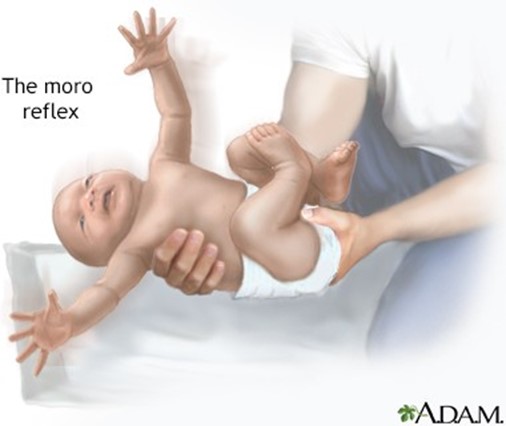A nurse is collecting data about reflexes from a newborn. Which of the following actions should the nurse take to elicit the newborn's Moro reflex?
Perform a sharp hand clap near the infant.
Turn the newborn's head quickly to one side.
Place a finger at the base of the newborn's toes.
Hold the newborn vertically, allowing one foot to touch the crib surface.
The Correct Answer is A
Choice A rationale:
The Moro reflex, also known as the startle reflex, is a normal reflex observed in newborns. To elicit this reflex, the nurse should perform a sharp hand clap or make a loud noise near the infant. This reflex is characterized by the baby's arms and legs extending outward, followed by a quick flexion, resembling a startle response. It is an important reflex to assess the newborn's neurological and motor development.
Choice B rationale:
Turning the newborn's head quickly to one side does not elicit the Moro reflex. This action may stimulate other reflexes, such as the tonic neck reflex, but it is not the appropriate method to assess the Moro reflex.
Choice C rationale:
Placing a finger at the base of the newborn's toes does not elicit the Moro reflex. This action is more related to testing the Babinski reflex, which involves the fanning and curling of the toes when the sole of the foot is stimulated.
Choice D rationale:
Holding the newborn vertically and allowing one foot to touch the crib surface does not elicit the Moro reflex. This action might elicit the stepping reflex, where the baby shows stepping movements as if walking when held in an upright position with their feet touching a surface.
Nursing Test Bank
Naxlex Comprehensive Predictor Exams
Related Questions
Correct Answer is ["A"]
Explanation
Choice A rationale:

The Moro reflex is a normal finding in newborns, including those born post-term. It is a primitive reflex that should be present and indicates a healthy neurological system.
Choice B rationale:
Vernix, a protective white substance that coats the skin in utero, is typically absent or minimal in post-term newborns due to its decreased production as gestation progresses. Therefore, it would not be expected in a post-term infant.
Choice C rationale:
Lanugo, the fine hair covering a newborn's body, is usually present in greater amounts in preterm infants. By the time a newborn is post-term, lanugo is typically sparse or absent, making it an unlikely finding.
Choice D rationale:
This maneuver assesses the flexibility of the newborn's joints. Post-term infants tend to have reduced flexibility and increased muscle tone, making this maneuver more difficult or restricted in this population.
Correct Answer is C
Explanation
Choice A rationale:
Activating respiratory arrest procedures is not necessary in this situation. The newborn's respiratory rate, although slightly elevated, does not indicate respiratory arrest. Instead, such procedures are reserved for situations where the newborn has stopped breathing or is in acute respiratory distress.
Choice B rationale:
Requesting an order for supplemental oxygen may be premature. The newborn's respiration rate of 44/min, although shallow with periods of apnea, is still within the normal range for a newborn. Providing supplemental oxygen should be considered when the newborn is showing signs of significant respiratory distress or if oxygen saturation levels are low.
Choice C rationale:
The most appropriate action in this scenario is to continue routine monitoring of the newborn's respiratory rate and overall condition. Newborns often exhibit irregular breathing patterns, including periods of apnea, especially in the first few hours after birth. As long as the newborn's color, heart rate, and overall appearance are stable, routine monitoring is appropriate.
Choice D rationale:
There is no need to report the observation to the charge nurse immediately, as the newborn's respiratory rate and pattern fall within the expected range for a 12-hour-old newborn.
Reporting should be considered when there are significant deviations from the norm or if the newborn's condition deteriorates.
Whether you are a student looking to ace your exams or a practicing nurse seeking to enhance your expertise , our nursing education contents will empower you with the confidence and competence to make a difference in the lives of patients and become a respected leader in the healthcare field.
Visit Naxlex, invest in your future and unlock endless possibilities with our unparalleled nursing education contents today
Report Wrong Answer on the Current Question
Do you disagree with the answer? If yes, what is your expected answer? Explain.
Kindly be descriptive with the issue you are facing.
